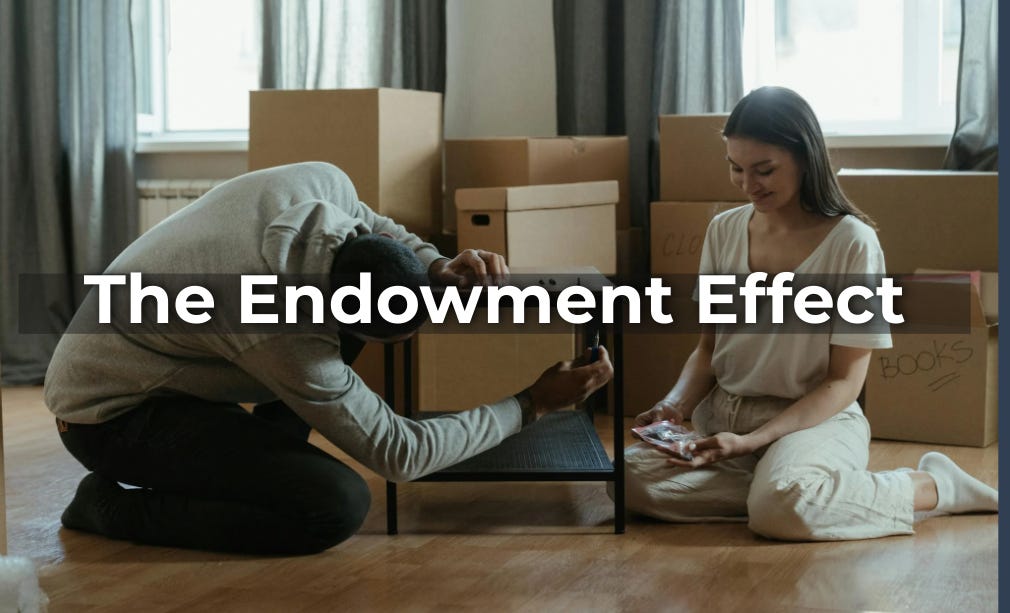Hello Captivate Community,
Welcome to the latest edition of CAPTIVATE! Every month, we bring you one tip to improve your communication skills through the power of persuasion. We scour the research on psychology, behavioral economics and influence to bring you the most actionable ways to increase your impact. Upgrade your conversations, boost your persuasion and become a master storyteller - in only 5 minutes each month.
Our Promise - keep it CIA. Concise, Insightful and Actionable!
Ever wonder why that chipped mug, a relic from your college days, feels irreplaceable? Or why your well-worn trainers, despite their holes, feel more valuable than a brand new pair? This isn't mere sentimentality. It's the endowment effect, a behavioural quirk that makes us value what we possess far more than what we could acquire and it holds great potential for your persuasion toolkit.
What's the Endowment Effect, Anyway?
Simply put, the endowment effect is the irrational, though totally understandable, tendency to inflate the value of something just because it’s ours. Whether it's a humble mug, our used car or our stock portfolio, studies have consistently shown that we place greater value on things already in our possession. It's like a mental boost that kicks in when we possess an item, making us reluctant to part with it even if we wouldn't have paid that much for it initially.
The endowment effect isn’t confined to ownership - it extends to the sweat equity we invest as well. Think about that DIY project you completed or that team brainstorm session that led to a breakthrough idea. The more we pour our time, energy, and creativity into something, the more its value appreciates in our mental accounting. In fact, the impact is so pronounced that it is sometimes referred to as the ‘Ikea Effect’ for the extra affinity we feel for the Billy Bookcase after putting in the elbow grease of building it.
Whether you're a marketer crafting a campaign or a CEO negotiating a merger, understanding the endowment effect helps unlock greater influence and persuasive power.
How can savvy business people like you harness this seemingly irrational bias to your advantage? Let's dive into three proven strategies:
The Power of Touch
Granting potential customers temporary ownership through free trials or samples can spark the endowment effect, making them more likely to commit to a purchase when the trial period expires. The allure of possession, even fleeting, can tip the scales in your favour.
Beyond Consumerism, Collaboration
Inviting clients into the creation process—through workshops, brainstorming sessions, or design input—fosters a sense of ownership and investment. This psychological buy-in makes them more likely to value the end product, transforming them from mere consumers into loyal advocates.
The Bespoke Experience
Offering personalized products or services—tailored suits, customized service, bespoke travel itineraries—taps into our primal desire for uniqueness. When customers actively participate in creating something tailored to their needs, the perceived value skyrockets.
It's time to put the endowment effect to the test! Here's your challenge for the month:
Experiment: Identify opportunities to foster a sense of ownership amongst your customers or employees. It can be as simple as asking for feedback on prototypes, a collaborative social media campaign, or hosting a virtual brainstorming session.
Engage: Create a space where individuals feel comfortable contributing their ideas and effort. Whether it's a digital suggestion box, a team-building exercise, or an open forum for discussion, the goal is to cultivate a sense of shared investment.
Empower: Recognize and celebrate the contributions of those who participate. Publicly acknowledge their efforts, implement their suggestions (where possible), and show appreciation for their involvement. This not only reinforces their sense of ownership but also fuels their commitment to your brand.
Remember: The endowment effect is a subtle but powerful psychological tool. Whether it's through ownership, effort, or co-creation, you can tap into this natural bias and nudge your customers towards better outcomes.
Want to Learn More? Check out these great resources:
You can find a simple overview on BehavioralEconomics.com here that outlines some of the original research by Richard Thaler, and separately by the late Daniel Kahneman.
For the updated view on the Ikea Effect, check out this article from The Decision Lab.
Did you enjoy this edition of Captivate? Don’t go another conversation without increased powers of persuasion - subscribe and pass it on to a friend.
We look forward to seeing you in July!
PS: due to the holidays in the first week of July, we will be publishing our next issue on July 9th.





